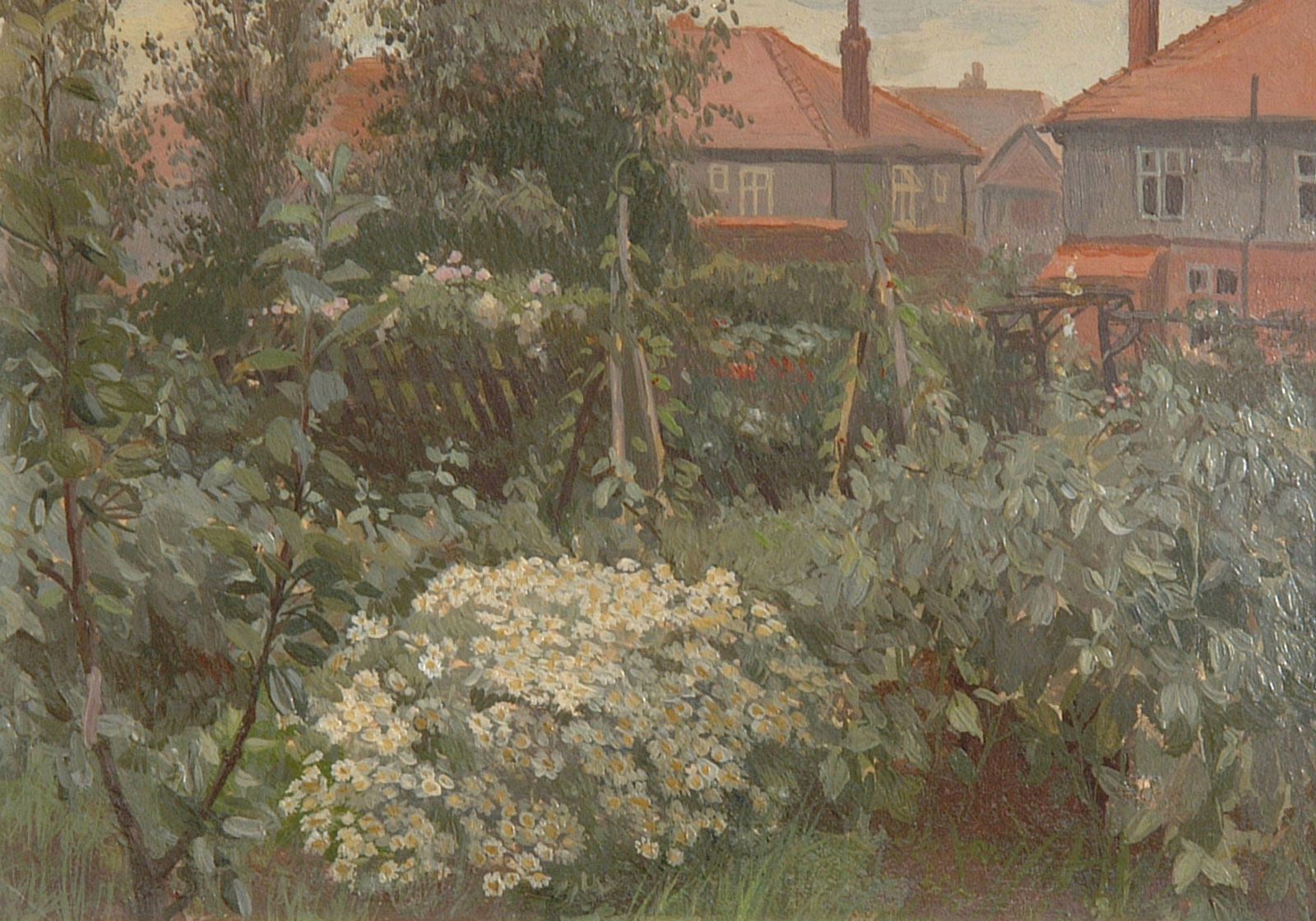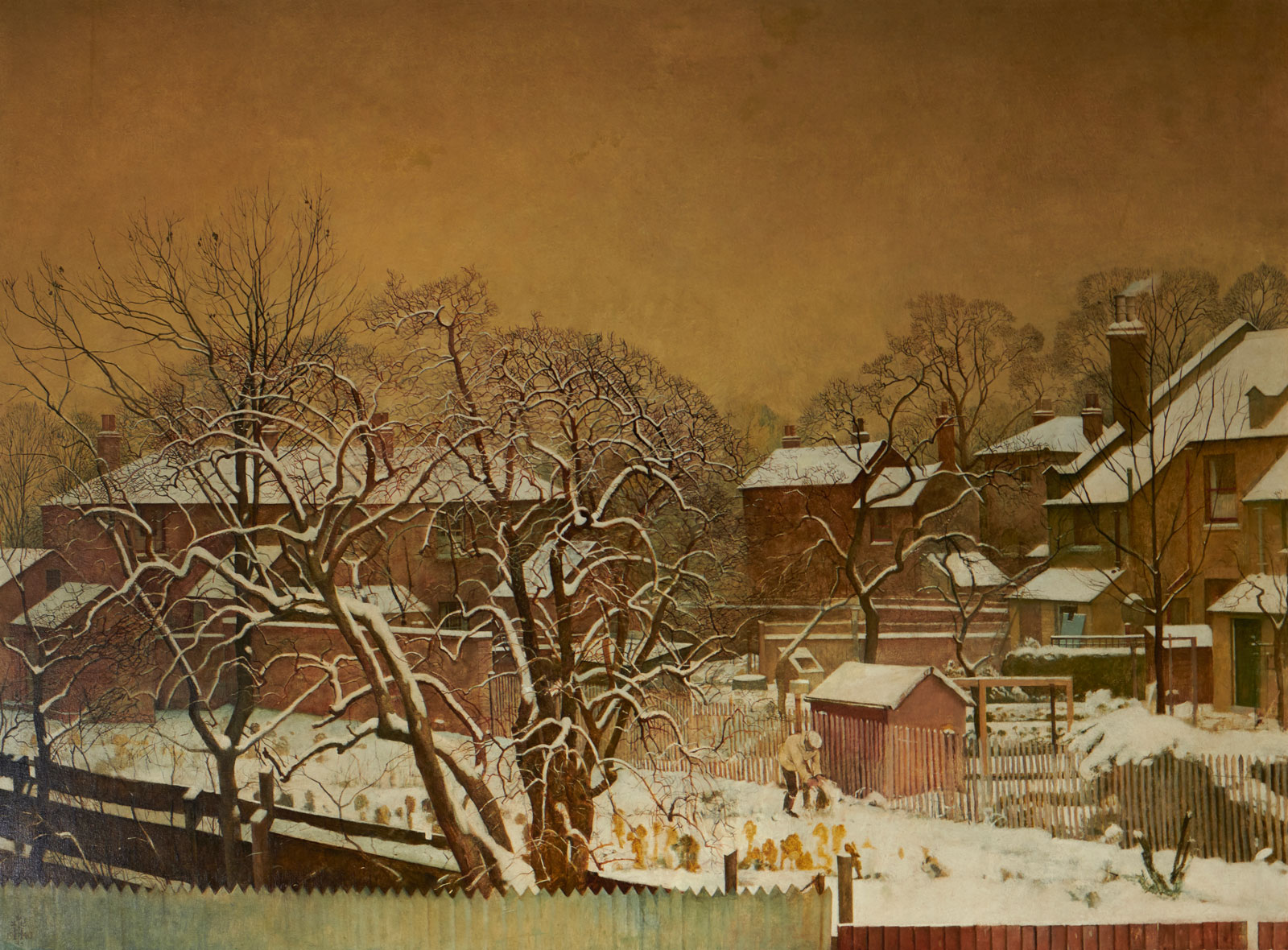A bright, blowy day in London. Blue sky, tumbling white clouds. The trees are budding in the parks, and even the brown Thames seems to sparkle. Could spring be coming? We are fed up with snow and floods and sad, bad news. Many of us—myself including—simply want to get into the garden. In tune with this mood, thank goodness, the Garden Museum in Lambeth is showing an exhibition called “Sanctuary: Artist-Gardeners 1919–1939.”
During World War I, when soldiers thought longingly of home, their minds often turned to the garden. Indeed, they made small gardens in the trenches, planting bulbs in empty brass shell-casings. In a catalog essay, the Garden Museum’s director, Christopher Woodward, quotes Ford Madox-Ford’s No Enemy: A Tale of Reconstruction (1929), on the soldier’s dream of return, not to a landscape but “a nook rather,” at the end of a valley “with a little stream, just a trickle level with the grass of the bottom. You understand the idea—a sanctuary.” So the focus of the show is not on great estates but on domestic landscapes and individual plants, and implicitly on the garden’s allegorical power: the myths of Eden.
The expected names are here: a pencil-and-watercolor sketch of periwinkles from John Nash; a wallpaper design by Eric Ravilious; a witty watercolour of bug, rose, and butterfly by Edward Bawden; erotic copperplates by Eric Gill, luscious wood-engravings (and blocks) from Clare Leighton and Gertrude Hermes. The emphasis, however, is on lesser-known artists, reinforcing the sense of gardening as a democratic pastime—or labor—enjoyed by women and men, young and old, in the country, the city, and the suburbs.
In 1919, Percy Horton, a bus driver’s son from Brighton, was returning home, not from the trenches but from Calton Jail in Edinburgh, where he had served two years’ hard labor as a conscientious objector. After studying at the Central School of Art, he went to the Royal College of Art in 1922, and was part of a circle of artist-gardeners taught there by John Rothenstein that included Charles Mahoney and Barnett Freedman, as well as Bawden and Ravilious. Horton’s untidy, rampant suburban garden swamps fences and pergolas and seems to rise like a tide toward the red-roofed houses themselves. Even artists who’d been too young to fight in the 1914–1918 war, like Bawden and Ravilious, felt the trauma of the conflict and turned to nature, to the countryside and the garden, in search of security, a sense of place, an assurance of continuity.
For the RCA group gardening also meant friendship. They exchanged cuttings and seeds, and when Bawden moved to Great Bardfield in rural Essex in 1930, Mahoney helped to dig out the garden there, planting sunflowers so tall that he had to prop a ladder up by the outside privy to draw them. His works of the 1930s are atmospheric and unruly, thick with dense color, whether outside, in a summer planting bed, or inside, in the steam of the greenhouse.
Mahoney was a skilled botanist, and in 1937, he and his former pupil, Evelyn Dunbar (best-known for her murals, and her paintings of the Women’s Land Army during World War II), wrote and illustrated the book Gardener’s Choice. Dunbar then went on, in 1938, to write the “Gardener’s Diary” for the magazine Country Life, a column full of witty pen-and-ink sketches, joyful personifications of each month. For July, a proud gardener tumbles his huge vegetables out of an outsize sack, a crop so heavy that it smashes a fence.
There is something wild and free here, a closeness of plant and human that is found, too, in Dunbar’s painting. In the unfinished Woman Tending Bocconea cordata (circa 1937), a determined woman—perhaps Dunbar herself—reaches into the stems to cut a dead leaf from the giant Plume Poppy propped against a warm south-facing wall. It’s a painting of striving and soaring, letting us feel how much Dunbar admires this majestic, resilient plant with its vivid surface and sheeny underside.
Despite the dates in the exhibition’s title, many works shown take us forward to World War II and beyond, as if to emphasize the garden’s enduring healing power. There are several winter scenes, touching in their ordinariness, like the photographs that we can’t resist taking out of our own kitchen windows when the snow sheds magic on a familiar world. Harry Bush and his wife, the artist Noel Laura Nisbet, lived in the same semi-detached house in Merton, south London, from 1914 until their deaths in the mid-1950s. In Snowfall in the Suburbs (1940), Bush’s back garden is blanketed by snow, with brick walls and paling fences, sheds and trees and frozen stumps of brussels sprouts, standing out in the whiteness. On August 16 that year, he painted a different transformation scene of the same houses, with their windows shattered by the bombing of the Blitz. Yet beyond the rubble-filled backyards, the trees are green and the marrows still climb over the roof of the small bombshelter.
Advertisement
All the paintings and engravings in this show are intriguing, and many are lovely, but there is something slightly uncomfortable, in gloomy post-Brexit times, about celebrating this particular kind of Englishness. It’s as if we are doomed now to cultivate our own gardens, turning our backs not only on Europe, but also on the rich diversity of our own society. But the exhibition also brings encouragement that we don’t have to bow our heads over our spades: the artists’ worlds are wider than the garden.
Percy Horton, for one, was on the advisory committee of the anti-fascist Artists’ International Association, which counted among its members Henry Moore, Oskar Kokoschka, and Lucien Pissarro, and also supported artist refugees from Nazi Germany. In order to look outward, to confront the world, we can still retreat to nature as a refuge and resource. The Garden Museum is itself a sanctuary, founded in 1977 on the south bank of the Thames in the abandoned church of St Mary’s, Lambeth, to save it from demolition. In the small churchyard is the tomb of John Tradescant, the first great British plant-hunter and gardener, whose collection of curiosities became the core of Oxford’s Ashmolean Museum.
The Museum used to be a dusty, echoing space with a collection of old tools and books, but now it is gloriously refurbished, airy, and bustling. When I saw the exhibition it was “Potato Day,” and the Museum’s glass-walled backroom was packed with people filling paper bags with sixty different varieties of spuds. Now is the time to put seed-potatoes out in the light to “chit”—to let the shoots develop—and then, so the old lore says, we should plant them on Good Friday. With Easter and spring-time, the garden bursts from the soil. And in summer, the suburban allotments will be full of vegetables, and the sunflowers will stand as tall and exuberant as those in Mahoney’s gardens.
“Sanctuary: Artist-Gardeners 1919–1939” is on view at the Garden Museum in Lambeth through April 5.








